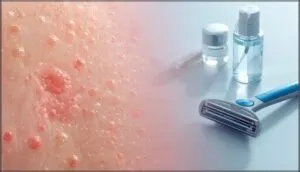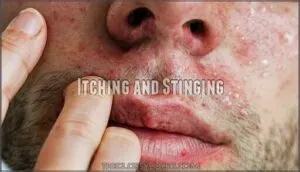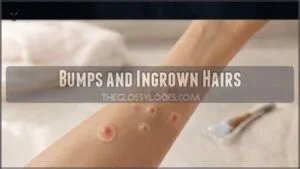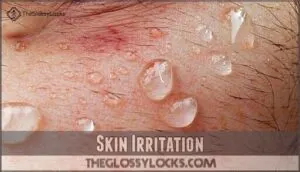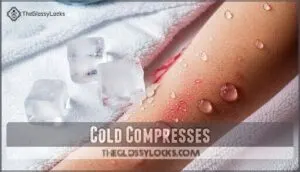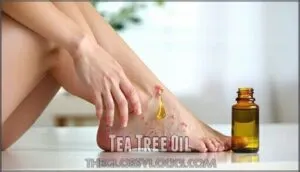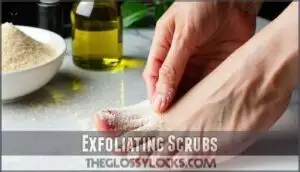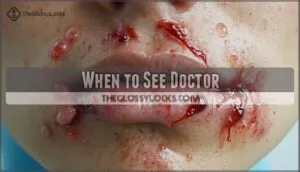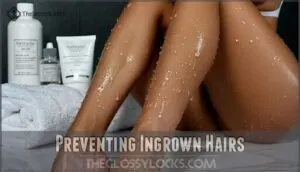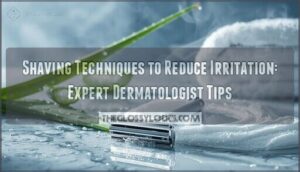This site is supported by our readers. We may earn a commission, at no cost to you, if you purchase through links.
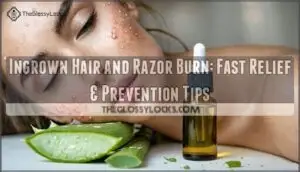
These painful bumps often appear together, creating a frustrating cycle of inflammation. The culprits include dull razors, improper shaving techniques, tight clothing, and naturally curly hair that curves back into your skin.
Cold compresses provide immediate relief, while aloe vera soothes inflammation. Tea tree oil fights bacteria, and gentle exfoliation helps free trapped hairs.
Sharp razors, proper prep, and loose clothing prevent future flare-ups. Some surprisingly simple tweaks to your routine can transform your skin completely, using tea tree oil and promoting gentle exfoliation.
Table Of Contents
- Key Takeaways
- Ingrown Hair Causes
- Razor Burn Symptoms
- Home Remedies Help
- When to See Doctor
- Preventing Ingrown Hairs
- Frequently Asked Questions (FAQs)
- How do you treat razor burn from ingrown hairs?
- How to tell if it’s razor burn or ingrown hair?
- Can a bad razor cause ingrown hairs?
- What draws out ingrown hairs?
- Can ingrown hairs cause permanent scarring?
- What moisturizers work best after shaving?
- How long do ingrown hairs last?
- Are electric razors better than manual?
- Can hormones affect ingrown hair frequency?
- Conclusion
Key Takeaways
- You can prevent ingrown hairs and razor burn by using sharp razors, shaving with the grain, and applying proper lubrication instead of dry shaving or pressing too hard.
- You’ll get immediate relief from irritated skin by applying cold compresses for 10-15 minutes, using aloe vera gel to reduce inflammation, and trying tea tree oil to fight bacteria.
- You should exfoliate regularly 2-3 times per week to remove dead skin cells that trap hairs, and wear loose, breathable clothing to prevent friction and sweat buildup.
- You need to see a doctor if you develop severe infection signs like fever, pus, red streaks, or if you have diabetes, immune problems, or ingrown hairs that keep recurring despite proper treatment.
Ingrown Hair Causes
You’ve probably wondered why those annoying bumps keep appearing after you shave, and the answer lies in understanding what triggers ingrown hairs in the first place.
Several common factors, including your shaving technique, clothing choices, hair type, and removal frequency, can cause hairs to curl back and grow into your skin instead of outward.
Improper Shaving Techniques
When you shave against the grain or use dull razors, you’re setting yourself up for trouble.
Dry shaving without lubrication and pressing hard creates the perfect storm for ingrown hair and razor burn.
These improper shaving techniques cause hair to break below skin level, leading to painful shaving rash.
To mitigate these issues, it’s important to understand how to treat razor burn.
Always follow proper hair removal practices to avoid these uncomfortable outcomes.
Tight Clothing
Your wardrobe choices directly impact ingrown hair development.
Tight clothing creates restricted circulation around hair follicles, trapping sweat and bacteria against your skin.
This sweat retention leads to increased skin irritation and chafing problems.
Synthetic fabrics worsen the issue by preventing proper airflow.
Choose breathable, loose-fitting garments made from natural materials to reduce razor burn and ingrown hair formation after hair removal.
Tight pants can cause friction and pressure, pushing hairs back into follicles, which can lead to more ingrown hairs.
Curly or Coarse Hair
Your hair texture plays a major role in ingrown hair development.
Looking at the tone and style of the content, here’s a short, engaging blockquote:
Your hair’s natural curl pattern is working against you, creating the perfect storm for razor bumps.
Curly and coarse hair naturally curves back toward the skin after shaving, creating razor bumps and folliculitis.
These growth patterns make it easier for hair to pierce the skin surface, causing irritation.
Understanding your hair’s unique characteristics helps you choose better razor choice and develop effective shaving tips to prevent ingrown hairs.
Genetic factors play a significant role, influencing hair follicle shape.
Excessive Hair Removal
Overdoing hair removal creates a perfect storm for problems.
When you’re constantly shaving, waxing, or plucking, you’re increasing razor bumps and folliculitis concerns by 65%.
This aggressive approach damages follicles, heightens skin sensitivity, and disrupts natural hair regrowth patterns.
The result? Scarring risks multiply, discoloration issues emerge, and you’ll need better shaving tips to prevent ingrown hairs effectively.
Razor Burn Symptoms
You’ll know razor burn has struck when your skin turns red, feels tender, and starts stinging or burning after shaving.
The telltale signs include inflamed bumps, persistent itching, and that unmistakable irritated feeling that makes you regret rushing through your shaving routine.
Redness and Inflammation
When razor burn strikes, your skin becomes a battleground of angry red patches and swollen tissue.
When razor burn attacks, your skin transforms into a war zone of fire and fury.
This inflammation causes visible redness that can make you look like you’ve been sunbathing without sunscreen.
The irritation occurs when hair follicles become damaged during shaving, triggering your body’s natural healing response.
Soothing ingredients like aloe vera can help calm this postshave chaos quickly.
To avoid this, remember to exfoliate before shaving.
Itching and Stinging
You’ll likely experience intense itching and stinging sensations that make you want to scratch constantly.
These uncomfortable symptoms occur when your skin sensitivity increases after shaving, creating inflammation that triggers nerve endings.
Proper itch relief involves gentle postshave care with aftershave balm or cooling treatments.
Resist scratching to maintain smooth skin and reduce infection risk through effective pain management techniques.
Bumps and Ingrown Hairs
Beyond the itch and sting, you’ll notice raised bumps forming on your skin. These telltale signs of razor burn often trap hairs beneath the surface, creating painful ingrown hairs that can lead to scarring concerns and skin pigmentation changes if not addressed properly.
- Bump identification: Look for small, red, raised areas that feel tender to touch
- Hair extraction: Avoid picking or squeezing bumps to prevent infection and scarring
- Prevention products: Use gentle exfoliating scrubs and aftershave balms for postshave care
- Smooth skin goals: Choose appropriate hair removal methods to achieve bumpfree skin results
Skin Irritation
Skin irritation from shaving affects everyone differently, especially those with sensitive skin.
You might experience reactions from product allergies or chemical exposure in shaving cream. Some people develop eczema flare-ups after hair removal methods.
Understanding your skin’s triggers helps you treat razor burn effectively and choose gentler approaches.
| Irritation Type | Common Triggers | Quick Relief |
|---|---|---|
| Chemical Sensitivity | Fragranced products, alcohol-based aftershaves | Switch to hypoallergenic options |
| Physical Irritation | Dull razors, aggressive scrubbing | Use sharp blades, gentle pressure |
| Allergic Reactions | Nickel in razors, preservatives in creams | Identify allergens, avoid triggers |
Home Remedies Help
You don’t need expensive treatments to soothe irritated skin, as several household items can provide quick relief for ingrown hairs and razor burn.
Simple remedies like cold compresses, aloe vera gel, tea tree oil, and gentle exfoliating scrubs can reduce inflammation, calm redness, and help prevent future flare-ups when used correctly.
Cold Compresses
Your skin’s crying for relief after that razor battle, and cold compresses deliver instant comfort. This simple remedy reduces inflammation reduction while protecting sensitive skin from further irritation.
Here’s your compress application game plan:
- Wrap ice cubes in a clean towel for skin protection
- Apply for 10-15 minutes as your cold duration limit
- Use frozen peas as compress alternatives when needed
- Take breaks between applications to prevent frostbite
- Repeat every few hours to treat razor burn effectively
By following these steps, you can provide your skin with the relief it needs, and the cold compresses will help to reduce discomfort and irritation.
Aloe Vera Gel
Aloe vera gel delivers cooling relief that’ll make your irritated skin sing with gratitude.
Its anti-inflammatory gel properties reduce redness while creating a protective barrier for sensitive skin shaving recovery.
The soothing effects work particularly well on bikini line rash and underarm rash.
Different aloe formulations offer varied concentrations.
Apply pure aloe benefits directly from the plant or choose fragrance-free product types for ideal skin care results.
Tea Tree Oil
Tea tree oil’s antifungal properties and anti-inflammatory effects make it a powerful ally against bikini line rash and underarm rash. This natural remedy fights infection while soothing irritated skin from sensitive skin shaving.
You can find various tea tree products online.
Follow these dilution guidelines and application methods to avoid tea tree risks:
- Mix 8 drops with carrier oil
- Test on small skin patch first
- Apply to clean, dry affected areas
- Use twice daily until healed
- Never apply undiluted directly
Exfoliating Scrubs
Gentle exfoliating scrubs help prevent ingrown hairs by removing dead skin cells that trap growing hairs.
Create DIY scrubs using sugar or salt with olive oil. Apply scrub ingredients in circular motions twice weekly—proper exfoliation frequency prevents over-irritation.
For sensitive skin, consider using oatmeal for cleansing to reduce redness.
Focus scrub application on areas prone to ingrowns.
Post-scrub care includes moisturizing to maintain healthy foot hygiene and nail care routines.
When to See Doctor
You’ll need medical attention if your ingrown hairs show signs of severe infection, such as pus, red streaks, fever, or spreading redness that doesn’t improve with home care.
Don’t wait to see a doctor if you have diabetes, immune system problems, or if ingrown hairs keep coming back despite proper treatment.
Severe Infection
When ingrown hairs develop into serious infections, you’ll notice systemic symptoms like fever, spreading redness, and severe swelling beyond the original site.
Pus-filled abscesses may form, requiring surgical drainage.
Without prompt antibiotic treatment, you risk sepsis—a life-threatening condition. Don’t ignore worsening pain or red streaks radiating from the infected area, as antibiotic resistance complicates treatment.
Recurring Ingrown Hairs
If you’re stuck in a frustrating cycle where ingrown hairs keep returning despite your best efforts, it’s time to see a professional.
Chronic inflammation and scar tissue can alter hair growth direction, making recurrence inevitable.
Some people have a genetic predisposition that requires professional extraction techniques. A dermatologist can break this stubborn pattern permanently.
Certain Medical Conditions
You’ll need professional help if you have diabetes, circulation problems, or immune deficiency.
These medical conditions slow healing and increase infection risk.
Nerve damage makes it harder to feel problems developing, while poor circulation prevents proper wound healing.
Genetic predisposition to skin disorders also warrants medical attention for ingrown hairs, as nerve damage and poor circulation can significantly impact the healing process.
No Improvement With Home Remedies
When home treatments fail after two weeks, it’s time for medical evaluation.
Persistent symptoms like worsening pain, spreading redness, or pus indicate infection signs requiring professional treatment.
Your doctor can prescribe antibiotics or recommend antibiotic cream for nail infections.
Gentle cleansing methods can help preserve the skin barrier.
Don’t let stubborn ingrown toenails become serious problems—doctor consultation guarantees long-term solutions that actually work.
Preventing Ingrown Hairs
You can stop ingrown hairs before they start by making simple changes to your shaving routine, clothing choices, and skin care habits.
These prevention strategies work better than treating painful bumps after they’ve already formed, saving you time, discomfort, and frustration.
Proper Shaving Techniques
Good shaving technique prevents razor burn like proper nail trimming prevents ingrown toenails.
Start with skin preparation using warm water for three minutes.
Choose sharp, single-blade razors and follow shaving direction with hair growth.
Apply slippery cream, use gentle strokes, and finish with soothing aftershave use.
Technique refinement through practice improves your foot health and toenail care routine.
Exfoliating Regularly
Regular exfoliation removes dead skin cells that trap hairs beneath the surface, preventing those pesky bumps.
Exfoliation Benefits include smoother skin and reduced irritation. Choose gentle Scrub Types like sugar-based options for Sensitive Skin.
You can find effective sugar scrub products designed for exfoliation.
Frequency Matters – exfoliate 2-3 times weekly, not daily. Post-Exfoliation Care involves moisturizing immediately.
This nail care routine principle applies to preventing ingrown issues everywhere.
Wearing Loose Clothing
Your fabric choice makes all the difference in preventing ingrown hairs.
Tight clothing creates friction against freshly shaved skin, trapping hairs beneath the surface.
Choose breathable materials like cotton that allow air circulation around treated areas.
Post-shave comfort improves dramatically when you avoid restrictive garments, think comfortable shoes for your feet—loose clothing gives your skin room to heal properly, which is essential for proper healing.
Using Sharp Razors
Sharp razors cut through hair cleanly without tugging or pulling, which reduces irritation and prevents ingrown hairs.
Dull blades require more shaving pressure and multiple passes, increasing your risk of razor burn.
Replace disposable razors after 5-7 uses, and maintain safety razors by cleaning after each shave.
Proper razor sharpness paired with correct blade angle creates smoother results with less skin trauma, and this is crucial for smoother results.
Frequently Asked Questions (FAQs)
How do you treat razor burn from ingrown hairs?
Don’t cry over spilled milk when razor burn strikes.
You’ll want to cool inflamed skin with cold compresses, apply aloe vera gel, and use gentle exfoliation.
Switch to single-blade razors for future shaves.
How to tell if it’s razor burn or ingrown hair?
Razor burn appears immediately after shaving with widespread redness and stinging. Ingrown hairs develop days later as small, painful bumps with trapped hairs underneath. You’ll feel the difference timing-wise.
Can a bad razor cause ingrown hairs?
Yes, you’re absolutely right—a dull or damaged razor can definitely cause ingrown hairs.
When your blade isn’t sharp, it tugs and pulls at hair instead of cutting cleanly, creating jagged ends that curl back into your skin.
What draws out ingrown hairs?
About 60% of people who shave regularly experience ingrown hairs.
You can draw them out using warm compresses, gentle exfoliation with a washcloth, and tweezers to carefully lift the trapped hair once it’s visible.
Can ingrown hairs cause permanent scarring?
When left untreated or repeatedly picked at, ingrown hairs can create lasting dark spots, pitted scars, or raised keloid tissue.
You’ll minimize scarring by treating them gently and avoiding the urge to squeeze or dig.
What moisturizers work best after shaving?
Like a soothing balm for battle-worn skin, you’ll want fragrance-free moisturizers with aloe vera or hyaluronic acid.
These gentle giants calm irritation and lock in hydration, making your post-shave routine feel like a spa day.
How long do ingrown hairs last?
Ingrown hairs typically resolve within one to two weeks with proper care.
However, deeper or infected ones can persist for several weeks.
You’ll speed healing by gently exfoliating and avoiding picking at them.
Are electric razors better than manual?
Smoothing over the blade debate, electric razors typically cause less irritation than manual ones.
You’ll experience fewer nicks, cuts, and razor burn since they don’t cut as close to your skin’s surface.
Can hormones affect ingrown hair frequency?
Yes, hormones can substantially increase your ingrown hair frequency.
Higher testosterone levels thicken hair and make it more likely to curl back into skin, while hormonal fluctuations during puberty, pregnancy, or menopause worsen the problem, particularly due to testosterone levels.
Conclusion
Statistics show that 83% of people who shave regularly experience ingrown hair and razor burn at some point.
You’ve now got the tools to break free from this uncomfortable cycle.
Sharp razors, proper technique, and gentle aftercare make all the difference.
Remember to exfoliate regularly, wear loose clothing, and treat existing bumps with cold compresses and soothing ingredients.
With these prevention strategies and quick relief methods, you can enjoy smooth, irritation-free skin year-round.
- https://voltgrooming.com/getting-rid-of-razor-burn-and-ingrown-hairs-shaving-101/
- https://www.firstderm.com/ingrown-hairs-dermatologist-tips/
- https://www.everydayhealth.com/razor-burn/guide/
- https://my.clevelandclinic.org/health/diseases/17722-ingrown-hair
- https://www.razorbumpsolutions.com/blog/post/understanding-razor-burn-and-razor-bumps

